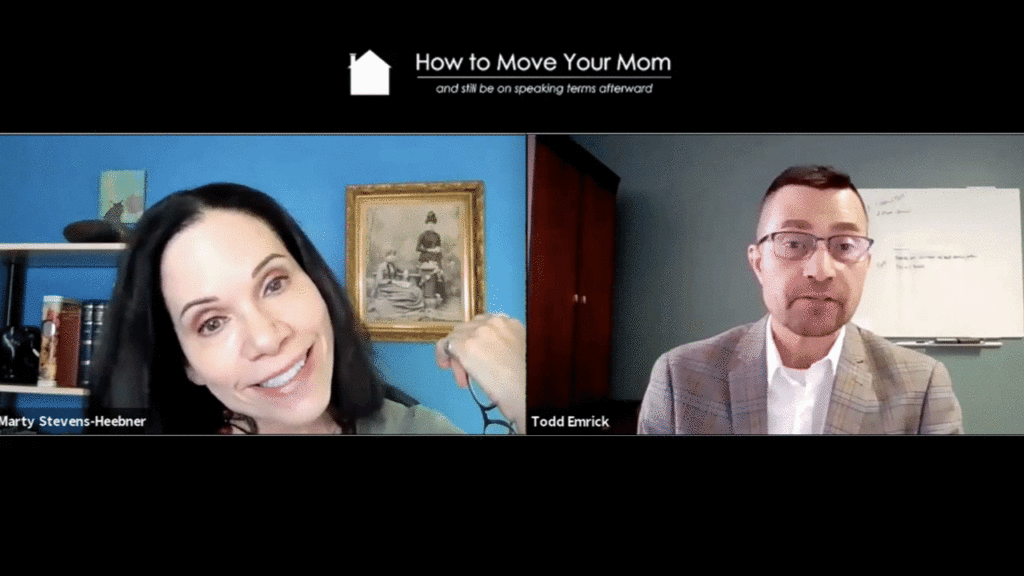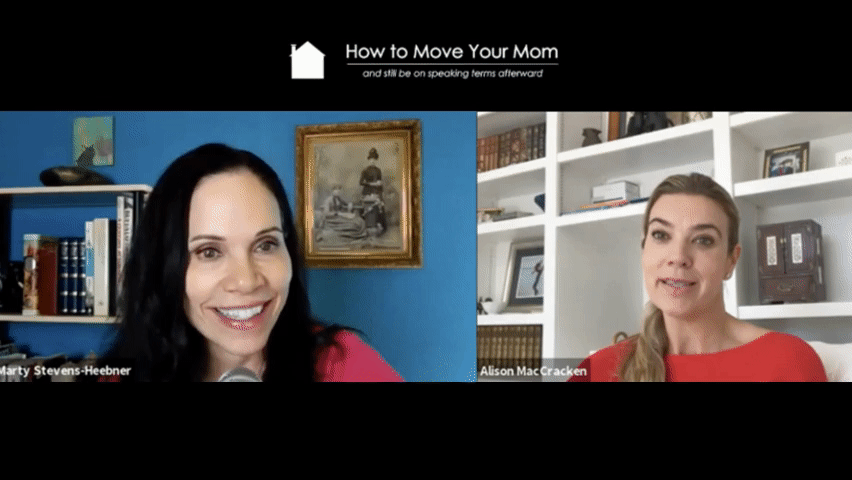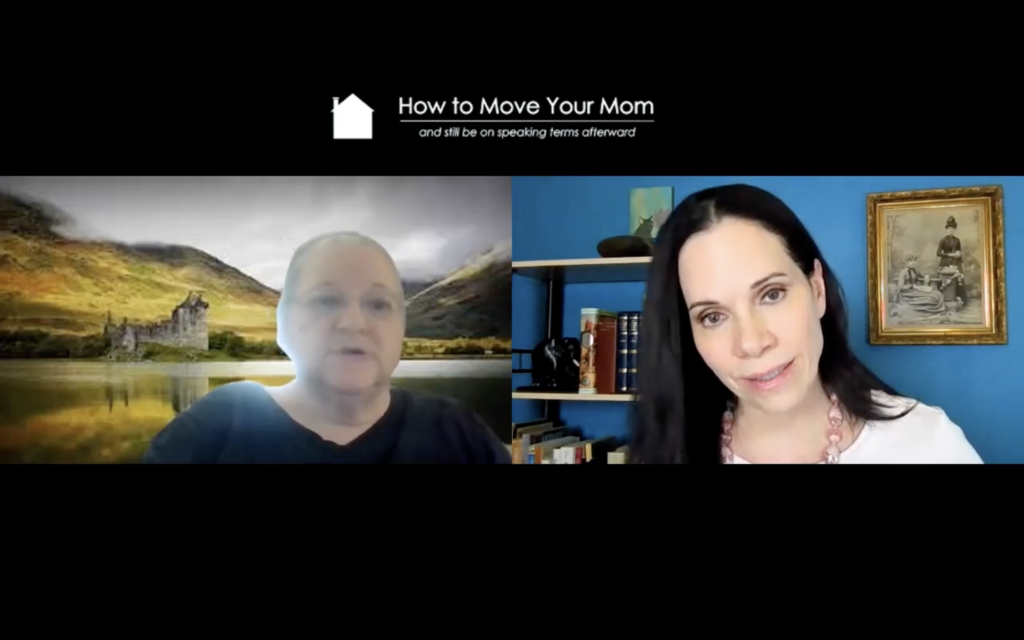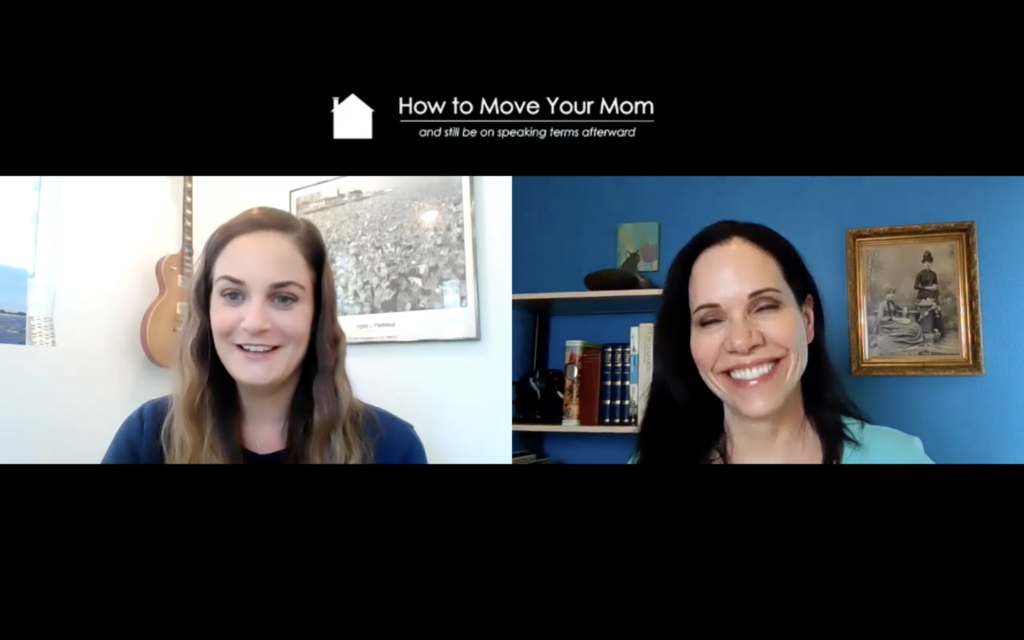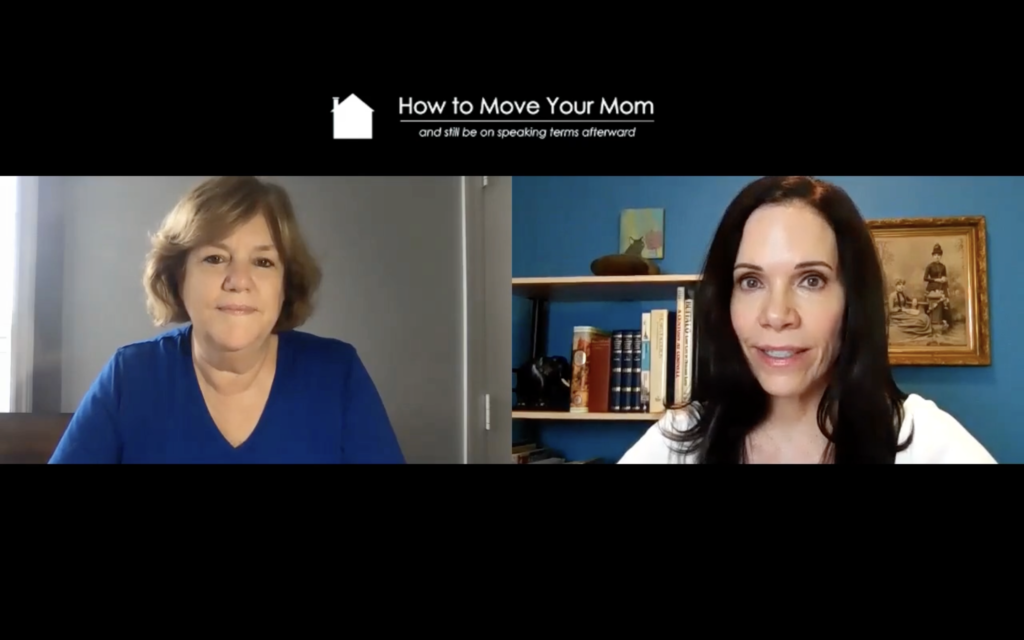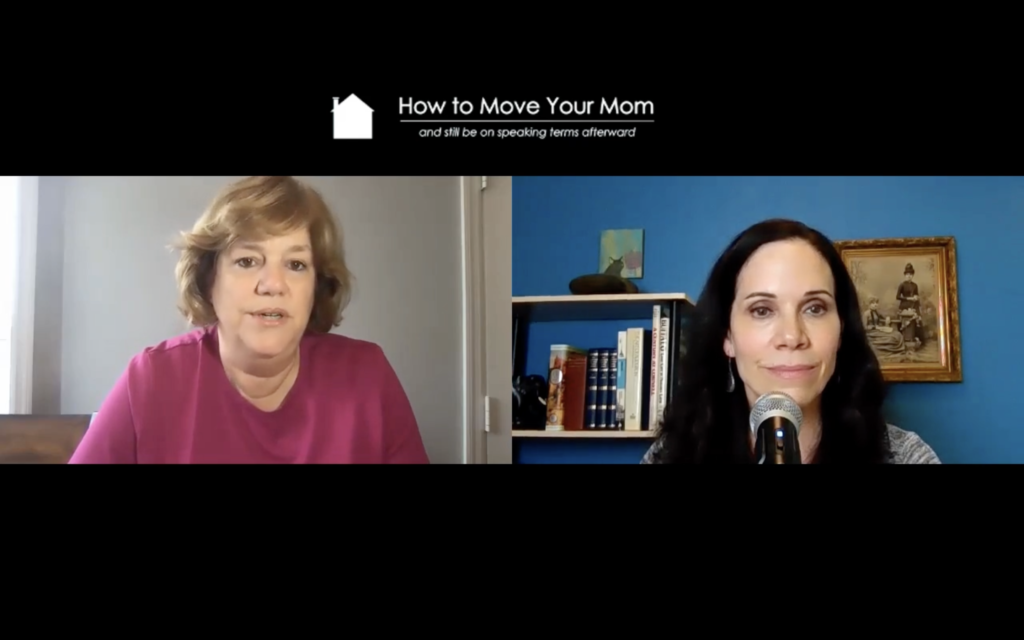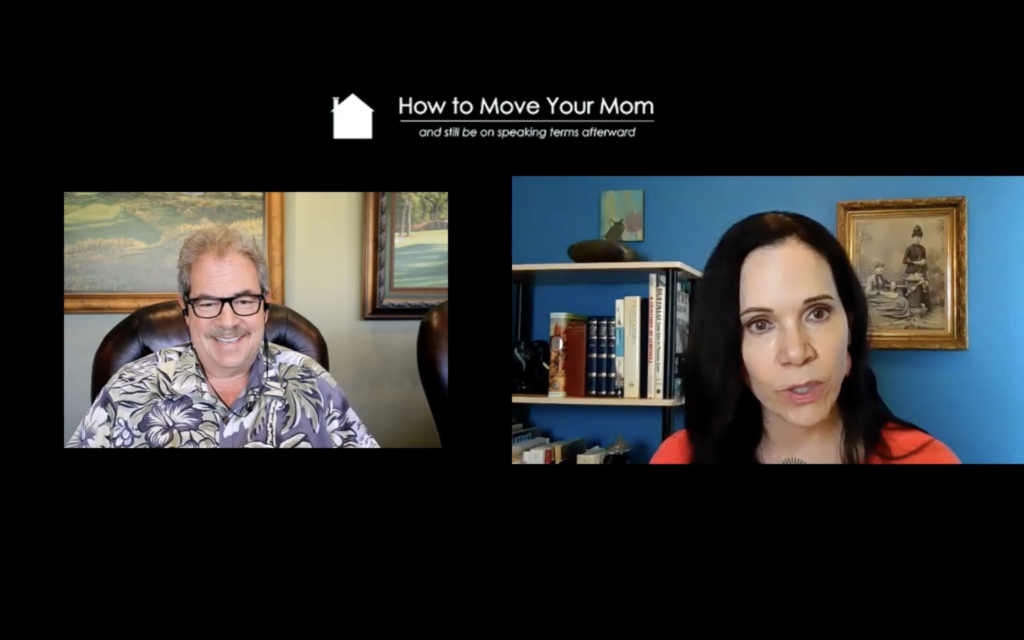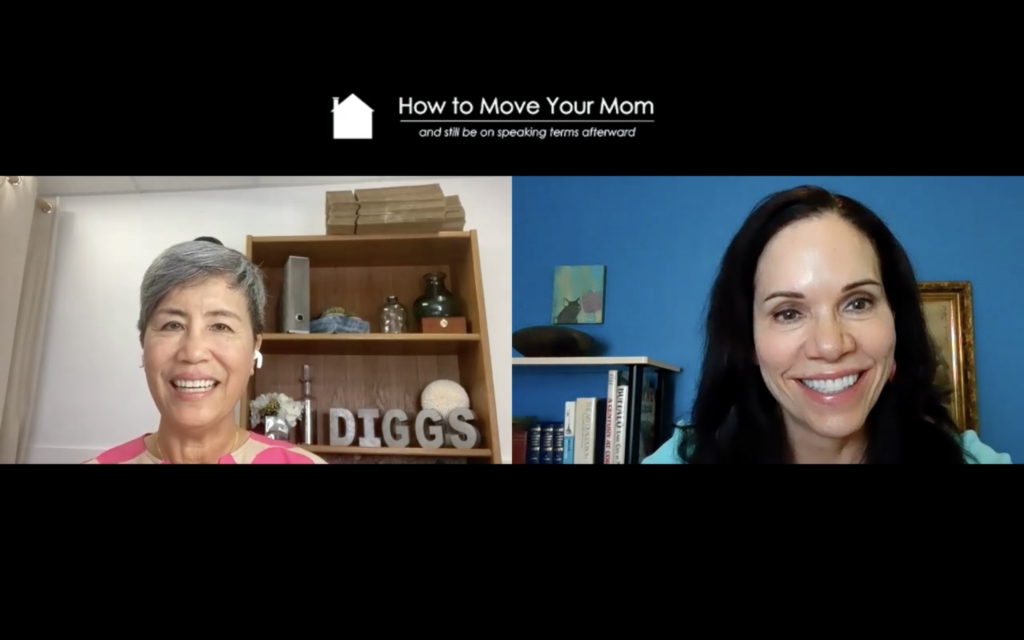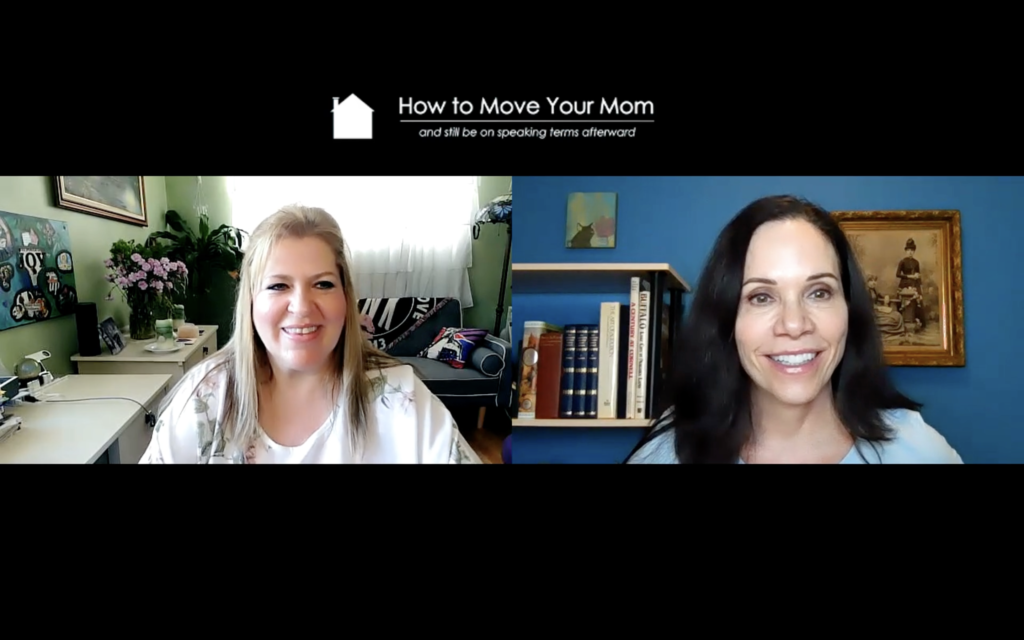This week's guest on How to Move Your Mom (and still be on speaking terms afterward) is @ToddEmrick. Todd is a 24-year veteran of the moving industry. As The Wheaton Group’s Director of Customer Service he has expertly shepherded clients from one end of their move to the other since 2004. Given that The Wheaton Group is the fourth largest household moving and transportation carrier in the United States, Todd gets a lot of phone calls, both from clients and move managers like Marty.
Episode Sponsor:
Clear Home Solutions takes care of a lifetime's worth of treasures - and all the emotions attached to them - when it's time for you or your senior parent to move or make their home safe and organized for their later years. Got photos? We can organize and digitize those for you, too.
What you will learn from this episode:
- The distinct difference between moving older adults and those of younger generations.
- Why delivery delays are the most challenging part of his job and what causes most of them.
- What questions people should ask moving companies as they consider working with them.
- The difference between packing by professionals versus families.
- What he wishes people knew about what he does.
- How he helped create a training program for moving agents and brokers that focused on moves for older adults.
- What advice he gives to people about how to set themselves up for success – or at least less stress – when they’re preparing to move.
Connect with Marty Stevens-Heebner:
Email: marty@clearhomesolutions.com
Marty Stevens-Heebner: (00:02)
Moving your mom or your dad or yourself isn't just about moving things from one place to another. It is much more complicated than that, as are so many things having to do with later life. How to move your mom and still be on speaking terms afterward provides in depth conversations with professionals, older adults and their family members who share their stories with warmth, understanding, and humor. I'm your host, Marty Stevens-Heebner, and here you'll find answers to many of your questions as well as different perspectives that I hope will inform and inspire you. Well, go to our next episode of How to Move Your Mom and Still Be On Speaking Terms Afterward. I am so happy to be with my dear friend and colleague, Todd Emrick of The Wheaton Group. Thank you Todd, for being here with me. I really appreciate it.
Todd Emrick: (00:54)
Absolutely. I'm very excited to be here.
Marty Stevens-Heebner: (00:56)
Oh, you're so great. Let me tell you a little bit about Todd here. My guest Todd Emrick is a 24 year industry veteran of the moving industry. As The Wheaton Group's Director of Customer Service, he has expertly shepherded clients from one end of their move to the other. Given that The Wheaton Group is the fourth largest household carrier in the United States, this means Todd gets a lot of phone calls, both from clients and professionals like me, move managers and members of the National Association of Senior and Specialty Move Managers, NASSMM for short.
Marty Stevens-Heebner: (01:33)
Todd goes out of his way to help his clients through experiences where the unimaginable sometimes happens. I can personally attest to the fact that he has the patience of a saint, is the common voice amidst the chaos of one of life's biggest upheavals, and has a killer sense of humor that can make you spit your scotch when you're having drinks with him. So Todd, you are the best. So what's your favorite memory of your grandparents?
Todd Emrick: (01:59)
I have to go back to my youth, long, long time ago.
Marty Stevens-Heebner: (02:04)
Not that long.
Todd Emrick: (02:05)
Where they had the farm and the family was always on the farm. Everyone was there, cousins, your uncles, your aunts, every Sunday everyone would go to my grandparents for a big family dinner and everyone would hang out. And that to me is the meaning of family, and that's what I think about when I think about my grandparents.
Marty Stevens-Heebner: (02:27)
Oh, how wonderful. It's such a bucolic scene.
Todd Emrick: (02:30)
It is.
Marty Stevens-Heebner: (02:30)
Whole family around the dinner table at the farm. I love that. Beautiful image. So let's talk about what it is about moving older adults that's so different from other moves.
Todd Emrick: (02:42)
Absolutely. I think it becomes much more complicated because one, you've got multiple players in the process. Many times you have the adult children that are trying to manage the move from another state. Sometimes you have senior move managers who are working to facilitate the move. You have a senior community that is trying to work the process for their own specific needs. So you're trying to put all of this together, make it one seamless process, and it can become quite complicated for not only me, but especially the older adult and the kids.
Marty Stevens-Heebner: (03:26)
So what is distinctive about your approach when you're dealing with those sorts of situations?
Todd Emrick: (03:31)
I try to educate everyone on the process and what their options are. You're the customer. You are the one that's moving. These are your items going on a truck. I want to make sure that you understand the process and one, are good with it, and two, it fits into what your needs are because every person truly does have different needs.
Marty Stevens-Heebner: (03:53)
Every situation is different. What do you love about your job? Aside from the fact that it's never boring.
Todd Emrick: (04:01)
It is never boring. In the 24 years that I've been doing this, I learn something new every week, and that's one of the things I truly love about it. And it truly is a group of committed people. Most of the people that have been in the moving industry have been doing this for many years, so they're experts in their field, but they truly understand the value that we bring to a customer and how important it is, and I love being around that group of people.
Marty Stevens-Heebner: (04:28)
I think a lot of people forget that movers are people too. Your drivers, for example, what's top of mind for them?
Todd Emrick: (04:35)
They want to provide an efficient experience for their customer. Remember, they've got multiple families on the truck, so if we can make sure that this move goes quick, efficient, without any problems, they can get back on the road and start moving on to their other customer. So it's planning, making sure that they know what's going on, making sure the customer knows, and everyone can get in and out.
Marty Stevens-Heebner: (04:59)
And sometimes that's a little trickier than other times. Without being too specific with names, we'll protect the innocent, what kind of things can happen?
Todd Emrick: (05:09)
You have delays. As I mentioned, you've got multiple families on the truck, and as that driver is moving across the country, if there is a problem on one shipment, it has a domino effect.
Marty Stevens-Heebner: (05:22)
Sorry, when you said multiple families on the truck, I thought of people on the truck. It's partial loads, partial loads from different families and so there are different stops sometimes along the way.
Todd Emrick: (05:31)
Correct.
Marty Stevens-Heebner: (05:31)
So please continue.
Todd Emrick: (05:33)
Absolutely. Yeah, that driver is picking up and delivering multiple shipments as he goes across the country, so if there is an issue with Mrs. Jones' shipment, that could potentially affect Mrs. Smith, who is two cities down the road. So we can either make up that time or we could potentially have a delay on our hands, and that becomes very stressful for everyone involved.
Marty Stevens-Heebner: (05:57)
And what can cause those delays? There can be the weather, but also having to drive around massive fires, we've got a big one going on in Northern California right now. But also, I'm assuming there can be blown out tires, big winds that topple trucks, or accidents and things like that sometimes.
Todd Emrick: (06:16)
Traffic. In the south you have hurricanes that we have to deal with every season, like you mentioned the fires out west. Mechanical failures. These guys put 100,000 miles on a truck like that so ...
Marty Stevens-Heebner: (06:28)
Wow.
Todd Emrick: (06:28)
At this point, you've got to make sure that you've got routine maintenance and you're trying to do that maintenance while you are also maintaining your schedule. So it becomes a balancing act to make sure that you're getting your maintenance in, you've got your safety checks in, because they are regulated, so there's a lot of things that go into play.
Marty Stevens-Heebner: (06:49)
I can only imagine, because I know from our perspective as the move managers, there are so many things you need to juggle. I think what really needs to be understood here is that every situation is unique and different. There are different people involved, different dynamics, different amounts of household goods, who's doing the packing, which we like to discuss packing by professionals versus families.
Todd Emrick: (07:14)
Sure. And you and I have had this conversation what? Every year, past nine or 10 years. You want to make sure that you have a professional job completed on your packing, especially when you're dealing with those sentimental or high value items. Let the professionals do those high value items, those fragile items, and if you want to be price conscious, go in, you can do the pots and pans, the books, the clothing yourself. Ultimately, if that box gets bumped around, it's not something that is fragile or breakable, it's a book, not something that's going to shatter.
Todd Emrick: (07:52)
And that leads into the coverage that we provide in our industry because of this if we are doing the packing and you're electing the higher level of coverage, then that item is covered. If you're doing the packing, it will limit the van line's liability or any van line's liability against damages. We don't know what's in the box, we don't know the preexisting condition of those items, so you need to be aware and not think you're saving money, but in the end, creating a mess for yourself on the back end to work through.
Marty Stevens-Heebner: (08:23)
It's really worth the investment. There have been times when we've had clients who are moving either interstate, in other words, not locally or across the country, and they haven't invested in the insurance and it's rare, but sometimes something breaks.
Todd Emrick: (08:38)
Limited liability coverage, what you get at no additional cost is $0.60 cents per pound per item. You take a look around your house, you're not going to be able to replace anything for that amount of coverage.
Marty Stevens-Heebner: (08:50)
Yeah.
Todd Emrick: (08:51)
It is not only peace of mind, but it is certainly an assurance that if something happens, you have a process in place with that van line to work through and bring a resolution to the damage.
Marty Stevens-Heebner: (09:04)
So when you purchase the bigger insurance plan from The Wheaton Group, for example, what all does that entail and cover?
Todd Emrick: (09:13)
Sure. And I have to point out it's not insurance, it's valuation.
Marty Stevens-Heebner: (09:18)
Thank you for clarifying that.
Todd Emrick: (09:20)
Absolutely. We are self funded so it's a declaration of value that you're providing for your goods. You would file a claim, it goes over to the claims department. With the higher level of coverage, a claim representative would come out, they assess the damage, report back to us. Then we take a look, if it is in fact transit related damage, at repair replace or cash settlement.
Marty Stevens-Heebner: (09:44)
Got it. That's very helpful because I think people really get confused about that, so that's definitely something you want to discuss when you're moving to find out what the costs are and things like that, and then realize it is an invest because you can have a very valuable painting that's maybe 8 inches by 10 inches and might weigh a pound and a half or two pounds.
Todd Emrick: (10:04)
Absolutely.
Marty Stevens-Heebner: (10:05)
And $0.60 on the dollar is not going to cover, that's for sure.
Todd Emrick: (10:09)
If you do have high value items, the industry, we do provide a form for you to outline those because it may be limited at $100 per pound, so you want to make sure that you're declaring your high value items and you may want to go and be a little bit proactive, maybe get an assessment on what they actually cost so if something does happen, you've got some documentation of the value of that particular piece.
Marty Stevens-Heebner: (10:36)
Yeah, we were once moving someone, it was local, but he had a couple of Chagalls, a Renoir. You have to realize, for example, those figurines, a lot of people like Lladro, or you have some crystal figurines that have fingertips.
Todd Emrick: (10:49)
Yes.
Marty Stevens-Heebner: (10:49)
Or little thin pieces that come out, we have to wrap each part of those completely. You have to be so careful for those so that they don't break at all.
Todd Emrick: (10:58)
And going interstate, we would probably recommend to create those.
Marty Stevens-Heebner: (11:02)
Even if they're small?
Todd Emrick: (11:03)
If you're looking at something of that high value, yes. I'm going to give you what it would cost to crate because it's going a thousand miles.
Marty Stevens-Heebner: (11:12)
Yeah.
Todd Emrick: (11:12)
Make sure that that is protected.
Marty Stevens-Heebner: (11:14)
That's a really good point. Can you explain what you mean by crating?
Todd Emrick: (11:18)
We have third party companies that we work with and they would actually come out and build a crate specifically for those items, just like the van lines, they had their own network so they would have someone come out on the front end, they would crate it up, at destination they would have another technician come out and uncrate the piece for you.
Marty Stevens-Heebner: (11:38)
This brings up a very important point. If someone is moving, how far ahead should you start to plan?
Todd Emrick: (11:45)
The typical rule of thumb is 30 days.
Marty Stevens-Heebner: (11:48)
That won't cut it.
Todd Emrick: (11:50)
The last couple years or anything, the typical. Absolutely. I'm going to say at least 60 days in advance you need to be calling your moving company, and even at that point, they've probably been working with a senior move manager or the senior community well in advance of that. Bring in all the players as soon as you can. Let me rephrase that, bring in the mover as soon as you know what is moving.
Marty Stevens-Heebner: (12:16)
Yes.
Todd Emrick: (12:19)
Important part, the wait. So if you're not sure of what's moving yet, it may be a little premature to bring us in, but you can still do your due diligence and start shopping around, doing some research on different companies.
Marty Stevens-Heebner: (12:32)
And also begin the sorting process. Work with a professional, like Clear Home Solutions, my company, or if you can do it on your own, which is wonderful, and you have help from family and friends, that's fantastic. I would say start 90 days beforehand, that way you will not be completely stressed out, and remember, that moving actually is one of the top stressors in the life. It's right up there with death, divorce, and moving. I don't call it relocation, I call it dislocation. Emotionally, you're going to feel at a joint until you're settled in to your new home for probably about a month.
Marty Stevens-Heebner: (13:06)
When I have clients who are just so stressed out and nervous and they don't understand why they're feeling this way, I just say, "You're moving. This is normal. It stinks that you're feeling this way, but it's normal. And on the other side of this, you'll feel better. You're feeling dislocated right now. That's what's going on." And at least they don't think they're going crazy. This is part of moving, that big emotional feeling.
Todd Emrick: (13:27)
You bring up a good point. It doesn't end when everything gets into the truck. Now you've got to wait for everything to get there, so you've got to be prepared while you wait. Where is mom staying? Is she going to stay with you? Is she staying in a hotel? Do you have enough clothes for that transit time? Keep in mind, it could be up to two weeks before the goods are actually delivered, and that's without any delays. So you want to make sure the medication, the documents you need for closing on the new home, whatever you're going to need to survive, that's going to have to stay off the truck and go with you.
Marty Stevens-Heebner: (14:03)
Also, be aware that unless you're moving locally, you'll be given a delivery window.
Todd Emrick: (14:10)
Yes.
Marty Stevens-Heebner: (14:11)
Once things are getting on the truck. Sometimes we have people who are moving cross country who will say, "Well, it has to be there on such and such date."
Todd Emrick: (14:18)
Right.
Marty Stevens-Heebner: (14:18)
And that can't be guaranteed if you're moving out of your local area because you just never know what's coming up, plus if your load is a partial load, they need to wait until the truck is filled up and then they'll go.
Todd Emrick: (14:34)
More and more senior communities are requiring that. A lot of them I work with have limited appointments per day for deliveries, one or two deliveries per day.
Marty Stevens-Heebner: (14:44)
Right. That's right.
Todd Emrick: (14:45)
So what I have started doing is having all of our goods delivered into our local destination agent, turn around, use a smaller vehicle that can actually navigate those streets, and then make the delivery at the appointed time.
Marty Stevens-Heebner: (15:01)
And you bring up such an important point because depending on where you're living before you move or where you're moving to, if it's a narrow little highway or street, a big truck can't make it down there.
Todd Emrick: (15:14)
So we use a smaller truck. We could rent a U-Haul or a Penske, one that can actually navigate the street that's a little bit lower in height. The goods would then be shuttled to that over the road truck, where the driver would then take it onto the next location.
Marty Stevens-Heebner: (15:29)
Because sometimes you have overhanging tree branches, so these are just things to keep in mind and to kind of look around where you are when you're starting to think about moving.
Todd Emrick: (15:40)
That's one of the great things about the in home surveys versus a virtual survey. Virtual surveys are great, don't get me wrong, but with an in-home survey, you actually have a salesperson that is driving the route that the driver is going to be using to get to your location and they can actually understand how is he getting there, where is he going to park? That's one of the things that I truly think are missing out of the virtual sites.
Marty Stevens-Heebner: (16:03)
And that's so important, isn't it? If for any reason you do end up doing a virtual survey, do yourself and the moving company a favor and take a video out to your main street, if you live down a long driveway or on a small street, so they can actually see what the situation is. And in the event they have to shift things like that.
Todd Emrick: (16:22)
Right.
Marty Stevens-Heebner: (16:23)
It won't be a big surprise on move day.
Todd Emrick: (16:25)
Yeah, and keep in mind too. Google Maps only goes so far. And some of them, they are in trucks that can be up to 85 foot in total length and getting them in and out in hilly areas, short turns. Sometimes we just don't know until the driver attempts to pull up to the house, and then at that point we need to shift to plan B and get that smaller vehicle in play very quickly.
Marty Stevens-Heebner: (16:53)
And that can cause a delay.
Todd Emrick: (16:54)
It can. Absolutely.
Marty Stevens-Heebner: (16:56)
Yeah. What do you wish people knew about what you and your drivers and such do that they might not know already?
Todd Emrick: (17:06)
I think, one, you need to understand what we can, and I think more importantly, what we can't or shouldn't do, talking about those high value items. Stop, let's talk about those and make sure that they are created, and you do have documentation of the value of them. Wine collections, understand that these trucks are going over the mountains, through the hills, and are going through temperature changes, pressure changes. So you need to be aware if you are moving large collections, high value items, let's stop and have a conversation with the salesperson first before it gets down the road, and then we are trying to fix something.
Marty Stevens-Heebner: (17:49)
It's just like anything else, good prep means a better outcome. It's not always a perfect outcome because there's always hiccups. It's like a wedding or any big event, there's always some hiccups, but that way you've done as much as possible to prepare yourself for a successful move. Wheaton has a training program, I believe, for its drivers regarding the special care one has to take with older adults. I think you helped to create that. Am I right?
Todd Emrick: (18:16)
Yes. Myself and people much smarter than I actually put it together. Yes.
Marty Stevens-Heebner: (18:23)
No one is smarter than you, Todd. No one.
Todd Emrick: (18:26)
Thank you. But it actually goes beyond the drivers. It's an entire program that takes not only a driver, but your salesperson, the manager at the local agent, and the crew leader. Because there are so many people involved, we want to make sure that they truly understand as a whole what's going on. How older adults actually manage things different. Do they take their medications in the morning? Do they go to bed early? These are the conversations that need to be had, and the training teaches you to have with the customer well before this all starts. Because if this isn't documented, if this isn't laid out and coordinated in advance, it's not going to happen. This is going to create the chaos that you're trying to avoid.
Marty Stevens-Heebner: (19:11)
Well, and it's so difficult because people are moving from their homes of 40 and 50 years.
Todd Emrick: (19:16)
Yes.
Marty Stevens-Heebner: (19:17)
They haven't moved since the 1970s or even 60s or 80s maybe, and it's so different now. And then on top of it, I literally had a client once say to me, this is a little gruesome, but she said, "I feel like I'm moving to the place I'm going to die."
Todd Emrick: (19:36)
Yes.
Marty Stevens-Heebner: (19:36)
Because she was moving to a community. And frequently with older adults, and family members need to be tuned into this, that may not be what they're consciously thinking, but it's going on somewhere in the back of their mind. So there's a lot more care one needs to think about when speaking to them about their things and where they're going. This is a really emotional time, and sometimes a frightening time for them. If they have dementia, even early stage dementia, there's usually some sun downing, so that means later in the day their cognitive abilities are not as strong as they are earlier. So when you're moving, and also if you're working with a move manager to go through items, do it earlier in the day, usually between about 10 and 3:00 PM, because you want people as present as possible and it can be an exhausting process, that whole sorting and move day is exhausting for them especially.
Marty Stevens-Heebner: (20:34)
I imagine when they're actually getting estimates, they're meeting with the representative from the company, they need to ask as many questions as come to mind because there are no stupid questions when it comes to moving quite honestly.
Todd Emrick: (20:48)
No. No, absolutely. And understand, the estimates that we provide can be really complicated, so take the time to sit down and go line item by line item through this with your salesperson so you understand what this particular charge is. And I cannot stress this enough, when they tell you some, "Oh yeah, we can do that." Get it in writing.
Marty Stevens-Heebner: (21:10)
Oh, yes.
Todd Emrick: (21:11)
You're verifying everything that is said in writing. That way there is a clear line of communication of what was said and what the expectations are.
Marty Stevens-Heebner: (21:20)
That is so helpful, and especially when you're sitting there and maybe they use some moving terms that aren't obvious, don't be shy about asking them to explain what such and such means. People often think that movers unpack and set up your home, and that's not really their job.
Todd Emrick: (21:39)
No, absolutely not. So unpacking in our world is taking everything out of the box and laying it on the first available flat surface. That would drive me crazy. I would rather either have someone come in to do a turnkey or leave it in the box and where I can manage the unpacking on my own at my speed without it just being all laid out in chaos.
Marty Stevens-Heebner: (22:02)
Or like you say, turnkey, hire a move manager who can put everything away.
Todd Emrick: (22:07)
Absolutely.
Marty Stevens-Heebner: (22:07)
And I want to say too, have a floor plan. Have a floor plan.
Todd Emrick: (22:12)
Yes.
Marty Stevens-Heebner: (22:12)
Honestly, we do floor plans for our clients and we tape it up by the door as the movers come in, we can say, "Okay, that sofa goes over there in that room on the left wall." There's always a little more tinkering when you get on site, always, but at least there's a plan to start with. It's so important. Make sure you put together a floor plan, you'll be so glad you did.
Todd Emrick: (22:33)
And as a mover, we actually appreciate that. That goes back to the efficiency. That driver wants to come in, get everything unloaded, and if you've got someone sitting there, "Maybe the couch should go over there." No. No, we need to keep on moving.
Marty Stevens-Heebner: (22:47)
What question should people ask professionals like you, as they consider working with a moving company?
Todd Emrick: (22:54)
One, are they a mover? Are they a broker? Are they affiliated with a van line or are they independent? These are the things that you can use to find out really who you are working with. Is it an established van line? How long have you been in business? So you want to start understanding who these people are.
Marty Stevens-Heebner: (23:14)
What's the difference between a moving broker and an agent?
Todd Emrick: (23:17)
Take Wheaton Van Lines. We are the interstate carrier and we are made up of agents. They are independently owned and operated companies, so if you're doing a local move, they are doing it under their own name, their own authority. They come to us and run under our authority for interstate moves. So that's what we as the van line provide is that interstate hauling authority.
Marty Stevens-Heebner: (23:39)
And the broker?
Todd Emrick: (23:42)
The broker is a guy that is sitting in an office complex somewhere that is taking your information, giving you a price, and then selling that to other moving companies, the people that actually have the trucks.
Marty Stevens-Heebner: (23:58)
Oh.
Todd Emrick: (23:58)
So you don't know who is going to show up on the day of your move.
Marty Stevens-Heebner: (24:03)
Well, that's the problematic.
Todd Emrick: (24:05)
You can go to protectyourmove.gov. This is an arm of the federal Motor Carrier Safety Administration that oversees our industry.
Marty Stevens-Heebner: (24:13)
Oh.
Todd Emrick: (24:14)
You can contact this person for their motor carrier number or their US DOT number. You can input that into the website. It'll tell you one, how many trucks they have. There's a dead give away, if they're trying to move you and they have zero trucks, that's not good.
Marty Stevens-Heebner: (24:28)
That's not very good. Right. Right.
Todd Emrick: (24:30)
I would also ask them what's their physical address. I'd love to come see your warehouse. So if they don't have a physical address, that's a dead giveaway that that's actually a broker.
Marty Stevens-Heebner: (24:42)
That makes a lot of sense. So yeah, definitely working directly with someone from the actual van line. Todd, I've got to ask you, what's the toughest part of your job?
Todd Emrick: (24:51)
So it's talking to customers and telling them that there is a delay and working through those issues. We have everything they own and now their new life that they're transitioning to is, as you said, being disrupted again.
Marty Stevens-Heebner: (25:06)
Yeah.
Todd Emrick: (25:06)
They're not able to move forward to their next chapter. Emotions run very high.
Marty Stevens-Heebner: (25:13)
Yeah.
Todd Emrick: (25:14)
Especially if the delay is more than a day or two, and it does happen, especially if you do have a truck that has a mechanical failure, that becomes very hard.
Marty Stevens-Heebner: (25:25)
When there's a mechanical failure, it could be out in the middle of "nowhere" so they have to wait to get the truck fixed. They can't just offload the goods when they have a very large truck.
Todd Emrick: (25:38)
We can try to do that sometimes. Particularly this year, there's no other trucks to be found. When something does happen, it's hard to recover at this point.
Marty Stevens-Heebner: (25:49)
Let's say somebody's moving cross country, in terms of the delivery window that they're given, is that about a week long? Is it 10 days long? What is it?
Todd Emrick: (25:57)
It depends on the size of your shipment. The larger the size of your shipment, the more space you take up in the truck, the more you can command that. If you have a smaller shipment, say you're moving to a one bedroom in a senior community, you've probably got a window of seven to 14 days. That's a lot of uncertainty for an older adult in the family. Be prepared. Please tell your mom and dad, "This is the window." Not that, "The truck is going to be there next Thursday. It'll be fine."
Marty Stevens-Heebner: (26:23)
It's a little trickier working with clients with dementia, but when your parents have all their faculties, don't sugar coat it. Not that anyone is ever average, but can you give us an idea of the average weights and costs and that sort of thing?
Todd Emrick: (26:38)
Absolutely. We took a look at all of our survey respondents 55 and over. The average cost for a move was $6,900. Average mileage is 1,100 miles. So we're talking cross country moves or mid country at least, and the average weight was 8,200 pounds. So that's a lot of stuff, that rolls into a large financial factor for the customer.
Marty Stevens-Heebner: (27:06)
It's an investment and be aware of that, and you don't want to go with the cheapest mover, even locally when you're moving locally, make sure they have insurance, liability, and workers comp, because you want to make sure they're using employees and not subcontractors that they just pull in on occasion. I have told so many friends, first of all, it's silly that they don't ask me for recommendations. Hello, this is what we do. And then if I find out they've hired a mover, I say here's a list of questions I want you to ask them, and it's often about insurance and employees, and now I'm going to add broker and agent, because it's very distinctive. I always call you, so I don't worry about that.
Todd Emrick: (27:48)
Right. Use your connections. Absolutely.
Marty Stevens-Heebner: (27:51)
It's kind of like a doctor.
Todd Emrick: (27:53)
Right.
Marty Stevens-Heebner: (27:53)
You want a good recommendation. So just so everybody knows ...
Todd Emrick: (27:57)
And a good outcome.
Marty Stevens-Heebner: (27:58)
Yeah, and a good outcome. Absolutely. Everything is still intact and ready to go. So Todd, your contact information, and thank you so much for sharing it with our audience, will be on the How to Move Your Mom and Still Be On Speaking Terms Afterward website, and that website is HowtoMoveYourMom.com. Thank you, Todd, for taking the time out of what I know is a very busy day. I'm so grateful to you.
Todd Emrick: (28:23)
Thank you again for having me.
Marty Stevens-Heebner: (28:27)
Thank you so much for listening to How to Move Your Mom and Still Be On Speaking Terms Afterward. Please visit HowtoMoveYourMom.com for more information about this episode and for additional podcast episodes featuring other extraordinary guests and conversations. Until next time, this is your very grateful host, Marty Stevens-Heebner.
